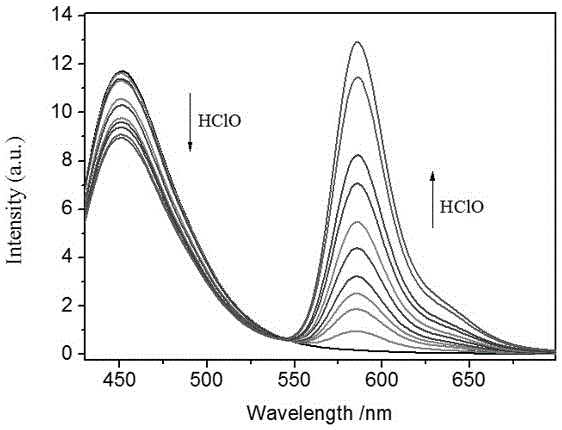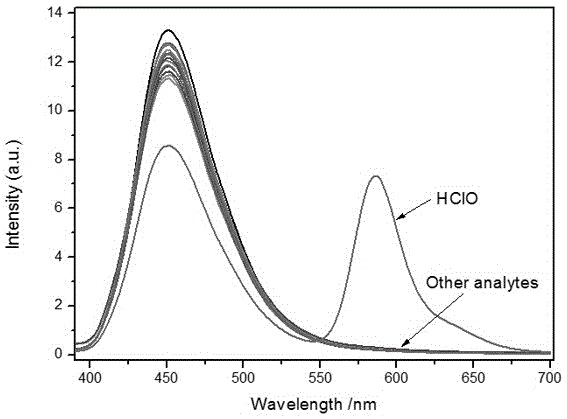Lysosome targeted fluorescence probe for detecting hypochlorous acid molecules, as well as preparations method and application thereof
A fluorescent probe and hypochlorous acid technology, applied in the field of analytical chemistry, can solve the problems of lack of hypochlorous acid detection tools, lack of targeting of hypochlorous acid, inability to detect hypochlorous acid, etc., and achieve strong anti-interference ability of other molecules , high coincidence rate, and simple post-processing
- Summary
- Abstract
- Description
- Claims
- Application Information
AI Technical Summary
Problems solved by technology
Method used
Image
Examples
Embodiment 1
[0036] Preparation of target probe compound Lyso-ClO
[0037] (1) Synthesis of compound Lyso-1
[0038]4-Diethylaminoketoacid (1.0g, 3.19mmol, 1eq) and 4-benzothiazole-1,3-resorcinol (776mg, 3.19mmol, 2eq) were dissolved in 5mL methanesulfonic acid solution, nitrogen Protected, heated at 90°C, and reacted for 24h. Use a TCL plate to detect the reaction. After the reaction is complete, cool the reaction solution to room temperature, slowly pour the reaction solution into 50 mL of ice water, extract with methanol / dichloromethane = 1:10, dry over anhydrous sodium sulfate, and spin the solvent under reduced pressure. The crude product was obtained and separated with a silica gel column, the silica gel particle size was 200-300 mesh, the eluent ratio was methanol / dichloromethane=1:30, and the yield was 64%. The synthetic route is as follows:
[0039]
[0040] (2) Synthesis of compound Lyso-2
[0041] Compound Lyso-1 (300mg, 0.574mmol, 1eq) was dissolved in 10mL of absolute e...
Embodiment 2
[0050] Changes in the fluorescence spectrum of the compound Lyso-ClO hypochlorous acid fluorescent probe with the increase in the equivalent of hypochlorous acid
[0051] The Lyso-ClO hypochlorous acid fluorescent probe prepared in Example 1 was dissolved in dimethyl sulfoxide (DMSO) to prepare a 1 mmol / L stock solution. Take 30 μL from the stock solution and add it to a 5mL centrifuge tube, add different equivalents (0-30eq) of hypochlorous acid standard solutions, and use PBS buffer solution (0.1mol / L, pH=7.5) and DMSO at a volume ratio of 1: The solution of 1 was diluted to 3mL, and its fluorescence properties were measured with 365nm as the excitation light. Fluorescence spectra such as figure 2 shown. Depend on figure 2 It can be seen that the fluorescence at 450nm gradually weakens and the fluorescence at 585nm increases gradually with the increase of hypochlorous acid equivalent added.
Embodiment 3
[0053] The Selectivity of Compound Lyso-ClO Hypochlorous Acid Fluorescent Probe to Different Molecules or Ions
[0054] Take out 30 μ L from the fluorescent probe stock solution in embodiment 2 and join in the middle of the centrifuge tube of 5mL, add the competing molecule standard solution of equimolar quantity respectively, one of them adds the hypochlorous acid standard solution of equimolar quantity, after 30min with PBS: DMF (1:1) is the solvent, and 365nm is the excitation light, and the fluorescence emission spectrum change of the detection solution is as follows: image 3 shown. Simultaneously, the influence of other metal ions on the fluorescence intensity of the probe of the present invention has also been studied. With PBS:DMF (1:1) as the solvent, 410nm is the excitation light, and the results are as follows: Figure 4 shown. Depend on image 3 and Figure 4 In general, it can be found that other metal ions have almost no effect on the fluorescence of compound...
PUM
 Login to View More
Login to View More Abstract
Description
Claims
Application Information
 Login to View More
Login to View More - R&D
- Intellectual Property
- Life Sciences
- Materials
- Tech Scout
- Unparalleled Data Quality
- Higher Quality Content
- 60% Fewer Hallucinations
Browse by: Latest US Patents, China's latest patents, Technical Efficacy Thesaurus, Application Domain, Technology Topic, Popular Technical Reports.
© 2025 PatSnap. All rights reserved.Legal|Privacy policy|Modern Slavery Act Transparency Statement|Sitemap|About US| Contact US: help@patsnap.com



